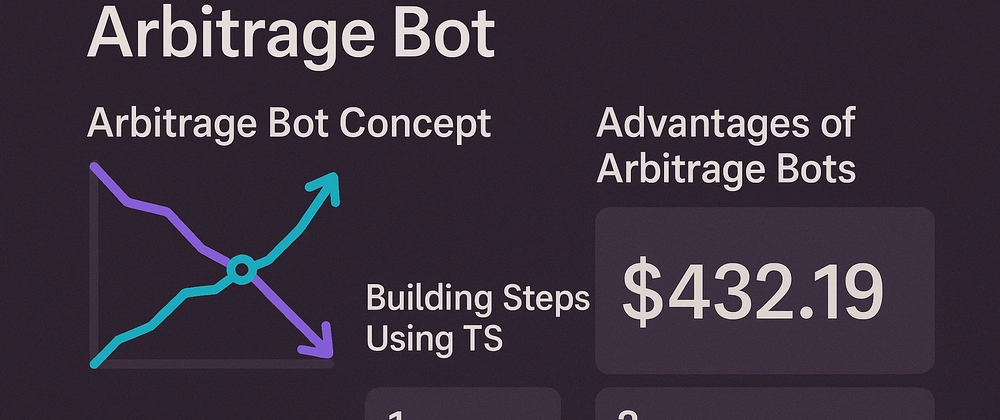How to build Solana Arbitrage Bot
Building a Solana Arbitrage Bot for Raydium and Pump.fun
Introduction
Arbitrage trading is a powerful strategy in the crypto world that allows traders to profit from price differences between different exchanges. In this article, we’ll build a Solana arbitrage bot that trades a single token between Raydium and Pump.fun, taking advantage of price discrepancies.
What is an Arbitrage Bot?
An arbitrage bot is a program that automatically detects and executes trades when there is a price difference for the same asset across multiple markets. In our case, the bot will monitor Raydium and Pump.fun for price variations and execute buy and sell orders to make a profit.
Types of Arbitrage
- Simple Arbitrage: Buying low on one exchange and selling high on another.
- Triangular Arbitrage: Involves three different assets for profit-making.
- Statistical Arbitrage: Uses mathematical models to predict profitable trades.
Our focus will be on simple arbitrage between Raydium and Pump.fun.
Why Use an Arbitrage Bot? (Advantages)
- Automated Trading: The bot operates 24/7, identifying opportunities faster than manual trading.
- Instant Execution: Eliminates the lag between identifying and acting on an arbitrage opportunity.
- High ROI Potential: Arbitrage trading can yield consistent profits with low risk compared to traditional trading strategies.
- Low Market Risk: Since arbitrage relies on price differences rather than market trends, it is less affected by volatility.
-
Numerical Profitability:
- Example: If TokenX is priced at $1.00 on Raydium and $1.05 on Pump.fun, a bot can buy at $1.00 and sell at $1.05, making $0.05 per token instantly.
- A trader manually executing these trades might be slower, reducing the profitability.
Challenges in Arbitrage Trading
While arbitrage sounds like a risk-free profit opportunity, there are challenges to consider:
- Transaction Fees: High gas fees can eat into potential profits.
- Slippage: Price fluctuations during execution may lead to lower profits.
- Execution Speed: Fast-moving markets require optimized bots for timely trade execution.
- Liquidity Issues: Low liquidity can prevent efficient trade execution.
Steps to Build the Solana Arbitrage Bot in TypeScript
1. Set Up the Development Environment
Install the required dependencies:
npm init -y
npm install @solana/web3.js axios dotenv
2. Connect to Solana Blockchain
import { Connection, clusterApiUrl } from "@solana/web3.js";
const connection = new Connection(clusterApiUrl("mainnet-beta"));
3. Fetch Token Prices from Raydium and Pump.fun
import axios from "axios";
async function getPriceRaydium(tokenAddress: string) {
const response = await axios.get(`https://api.raydium.io/v2/sdk/token/${tokenAddress}`);
return response.data.price;
}
async function getPricePumpFun(tokenAddress: string) {
const response = await axios.get(`https://pump.fun/api/token/${tokenAddress}`);
return response.data.price;
}
4. Detect Arbitrage Opportunity
async function checkArbitrage(tokenAddress: string) {
const priceRaydium = await getPriceRaydium(tokenAddress);
const pricePumpFun = await getPricePumpFun(tokenAddress);
if (priceRaydium < pricePumpFun) {
console.log("Buy on Raydium, sell on Pump.fun!");
} else if (pricePumpFun < priceRaydium) {
console.log("Buy on Pump.fun, sell on Raydium!");
} else {
console.log("No arbitrage opportunity found.");
}
}
5. Execute Trades (Pseudo Code)
async function executeTrade(action: string, exchange: string, tokenAddress: string, amount: number) {
console.log(`${action} ${amount} of ${tokenAddress} on ${exchange}`);
// Integrate with exchange APIs to execute trades
}
6. Automate the Bot
setInterval(async () => {
await checkArbitrage("TOKEN_ADDRESS_HERE");
}, 5000);
Enhancements and Next Steps
- Gas Fee Optimization: Ensure that the profits outweigh transaction fees.
- Slippage Protection: Implement safeguards to prevent losses due to price fluctuations.
- Multi-Token Support: Expand beyond a single token for increased profitability.
- Real Trading Integration: Connect APIs for automatic execution.
- Improved Order Execution: Use limit orders instead of market orders for better trade efficiency.
- Risk Management Features: Implement stop-loss mechanisms to minimize potential losses.
Conclusion
By building an arbitrage bot in TypeScript, we can take advantage of price inefficiencies between Raydium and Pump.fun. This bot can operate autonomously and optimize crypto trading strategies. With further enhancements, such as real-time execution, slippage protection, and risk management, this approach can be a sustainable source of profits in the volatile crypto market.
GitHub Repository
For the full source code and latest updates, check out the project on GitHub:
Solana Arbitrage Bot - Cross Exchange

